Snowshoe Dog Breeds are a fascinating group of canines native to snowy terrains in the US. They have specific characteristics and temperaments that make them well-suited for cold-weather climates. From the Akita to the Great Pyrenees, each breed has unique qualities that make them adaptable and resilient in snowy conditions. Learn more about these captivating breeds and their history in this article.
Key Takeaways:
- Snowshoe Dog Breeds are native to snowy terrains in the US.
- They have specific characteristics and temperaments that make them well-suited for cold-weather climates.
- Each breed has unique qualities that make them adaptable and resilient in snowy conditions.
- Understanding the history and characteristics of Snowshoe Dog Breeds is important for potential owners.
- These breeds offer a wide range of options to suit different needs, from loyal companions to therapy and service dogs.
The Versatility of Snow Dog Breeds in Cold-Weather Climates
Snow dog breeds are known for their pretty good adaptability and versatility in cold-weather climates. These breeds have unique characteristics and temperaments that make them well-suited for snowy environments, allowing them to thrive even in the harshest winter conditions.
One of the key features that sets snow dog breeds apart is their dense and insulating coat. This thick fur helps them stay warm and protected from the cold, allowing them to withstand freezing temperatures without discomfort. Their furry paws also provide them with excellent traction on icy surfaces, making them agile and sure-footed in slippery conditions.
When it comes to temperament, snow dog breeds are often highly resilient and independent. They possess a strong sense of adventure and love exploring the great outdoors, making them ideal companions for outdoor enthusiasts who enjoy winter activities. From hiking and skiing to sledding and snowshoeing, these breeds have the stamina and endurance to keep up with their human counterparts.
“Snow dog breeds are not only able to withstand the cold but also thrive in it, showcasing their pretty good adaptability and resilience.”
Some popular examples of snow dog breeds include the Alaskan Malamute and the Siberian Husky. These breeds have a long history of living and working in cold climates, and their natural instincts make them great sled dogs. Their pretty good strength and endurance allow them to pull heavy loads over long distances, making them invaluable when it comes to transportation in snowy regions.
Table: Snow Dog Breeds Comparison
| Breed | Coat Type | Temperament | Activity Level |
|---|---|---|---|
| Alaskan Malamute | Double coat with a thick undercoat | Friendly, affectionate, and loyal | High energy level, requires regular exercise |
| Siberian Husky | Double coat with a plush and dense topcoat | Intelligent, outgoing, and mischievous | High energy level, needs ample exercise and mental stimulation |
| Bernese Mountain Dog | Thick, double coat with a longer outer coat | Gentle, calm, and affectionate | Moderate energy level, requires regular exercise |
As outdoor enthusiasts, we can appreciate the versatility and adaptability of snow dog breeds in cold-weather climates. Whether you’re seeking a loyal companion for your winter adventures or a working partner for sled pulling, these breeds can bring joy, companionship, and unmatched endurance to your snowy escapades.
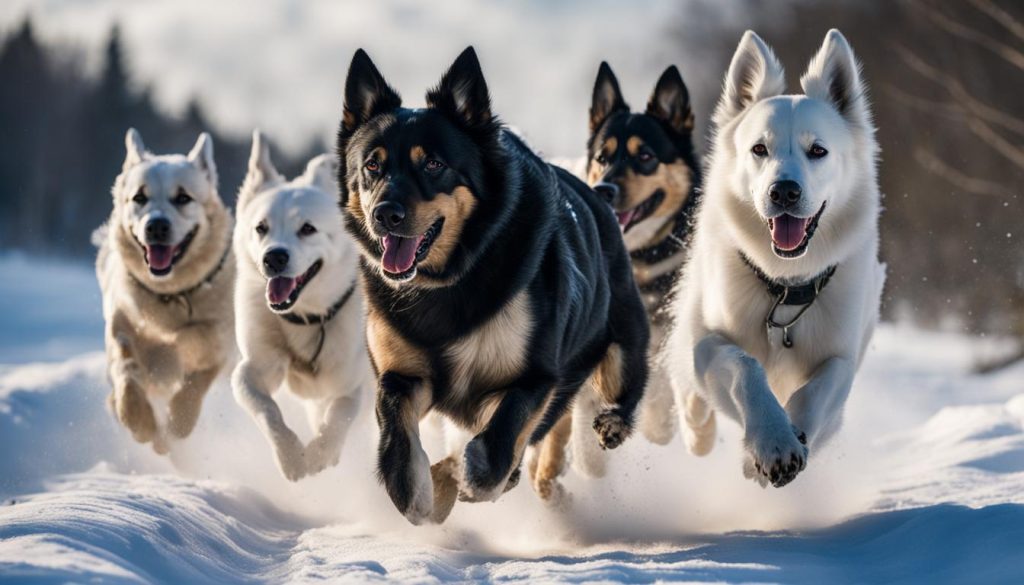
A Closer Look at Snowshoe Dog Breeds
Snowshoe Dog Breeds are a unique group of canines that thrive in snowy environments. They have specific characteristics and temperaments that make them well-suited for cold-weather climates. Let’s take a closer look at these fascinating breeds and what sets them apart.
Snowshoe Dog Characteristics
Snowshoe Dog Breeds often have dense coats, strong builds, and thick skin to protect them from the cold. Their fur acts as insulation, keeping them warm even in freezing temperatures. Some breeds, like the Siberian Husky and the Alaskan Malamute, have double coats that provide added protection from the elements. These dogs also have furry paws, which help them navigate icy terrain with ease.
Snowshoe Dog Temperament
The temperament of Snowshoe Dog Breeds can vary depending on the specific breed. Some breeds, like the Akita, are known for their independence and strong-willed nature. Others, like the Saint Bernard, are gentle and friendly. Many Snowshoe Dog Breeds are intelligent and trainable, but they may also have a stubborn streak. It’s important for owners to understand the temperament of their chosen breed and provide appropriate training and socialization to ensure a well-behaved and happy dog.
Snowshoe Dog Care
Proper care and grooming are essential for Snowshoe Dog Breeds to thrive in snowy conditions. Regular brushing helps to keep their coats clean and free from snow and ice. It also helps to prevent matting and tangling. These breeds may require extra attention during shedding seasons, as their thick coats can shed heavily. Additionally, protect their paws from ice and salt by wiping them clean after outdoor activities. Providing a warm and dry shelter is also crucial to keep them comfortable in cold weather.
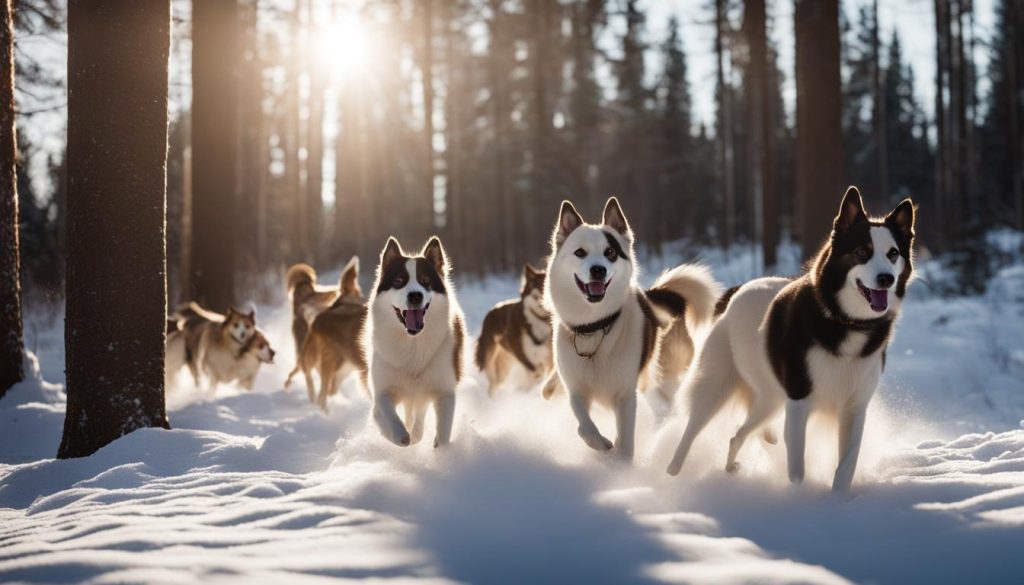
| Breed | Coat Type | Temperament |
|---|---|---|
| Akita | Double coat | Independent, loyal, protective |
| Siberian Husky | Double coat | Friendly, adventurous, energetic |
| Alaskan Malamute | Double coat | Loyal, strong-willed, affectionate |
| Saint Bernard | Long, dense coat | Gentle, friendly, patient |
Understanding the specific characteristics and temperaments of Snowshoe Dog Breeds is important for potential owners. These dogs require special care and attention in snowy environments to ensure their health and well-being. With proper care, Snowshoe Dog Breeds can bring joy and companionship to their owners in the beautiful winter landscapes.
Training and Care for Snowshoe Dog Breeds
Training and care for Snowshoe Dog Breeds requires special attention due to their unique needs in snowy environments. These intelligent and energetic dogs thrive with proper training and socialization to ensure their safety and obedience in cold-weather conditions.
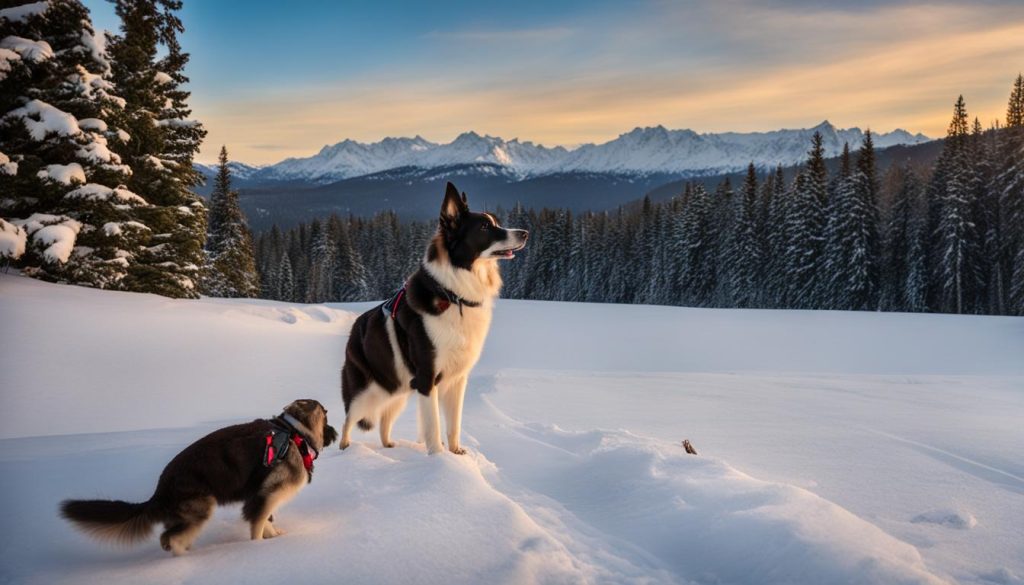
Training:
When it comes to training Snowshoe Dog Breeds, consistency, positive reinforcement, and patience are key. Start training from an early age to establish good behavior and prevent any potential issues. Focus on basic commands such as “sit,” “stay,” and “recall.”
Care:
Care for Snowshoe Dog Breeds extends beyond training. Regular grooming is important to keep their coats clean and free from ice, snow, and debris. Brushing their thick fur helps prevent matting and keeps them comfortable. Pay special attention to their paws, ensuring they are clean and free from snow buildup and ice balls.
Winter Dog Care:
In addition to regular grooming, Snowshoe Dog Breeds require special care during the winter months. Protect their paws from the cold and harsh surfaces by applying paw balm or using booties. Provide them with a warm and insulated shelter when they’re outside and always ensure they have access to fresh water. Adjust their diet as necessary to maintain a healthy weight and consult with a veterinarian for any specific dietary recommendations.
Cold-Weather Dog Care:
Proper care for Snowshoe Dog Breeds in cold weather also includes monitoring their activity levels. While these dogs are known for their high energy, they can easily become overexerted in extreme cold. Limit outdoor activities during extremely cold temperatures and be mindful of any signs of discomfort or frostbite. Protect their ears and tail with dog-friendly winter clothing if needed.
In summary, Snowshoe Dog Breeds require training and care tailored to their unique needs in snowy environments. Consistent and positive training, regular grooming, and special attention to their paws and overall well-being are essential for their health and happiness. With proper training and care, Snowshoe Dog Breeds can thrive and enjoy the beauty of winter alongside their owners.
The History of Snowshoe Dog Breeds
Snowshoe Dog Breeds have a fascinating history that dates back to their origins in snowy terrains. These breeds were specifically bred for their ability to thrive in cold-weather climates and perform various tasks in snowy environments. From hunting and herding to sled pulling, Snowshoe Dog Breeds have played crucial roles in the lives of people living in snowy regions.
One example of a Snowshoe Dog Breed with a rich history is the Akita. Originating from Japan, the Akita was once a royal dog exclusively owned by the Imperial family. These dogs were used for hunting in cold climates and were highly valued for their strength, loyalty, and adaptability to snowy terrains. The Akita’s history is a testament to the special qualities of Snowshoe Dog Breeds and their ability to thrive in harsh winter conditions.
The history of Snowshoe Dog Breeds is a testament to their resilience, adaptability, and unique characteristics that make them well-suited for snowy environments.
Table: Snowshoe Dog Breeds and Their Origins
| Snowshoe Dog Breed | Origin |
|---|---|
| Akita | Japan |
| Great Pyrenees | France |
| Siberian Husky | Siberia (Russia) |
| Alaskan Malamute | Alaska (USA) |
Understanding the history of Snowshoe Dog Breeds provides valuable insights into their specific characteristics and temperaments. It highlights their pretty good ability to adapt and thrive in cold-weather climates, making them well-suited for outdoor adventures and companionship in snowy landscapes.
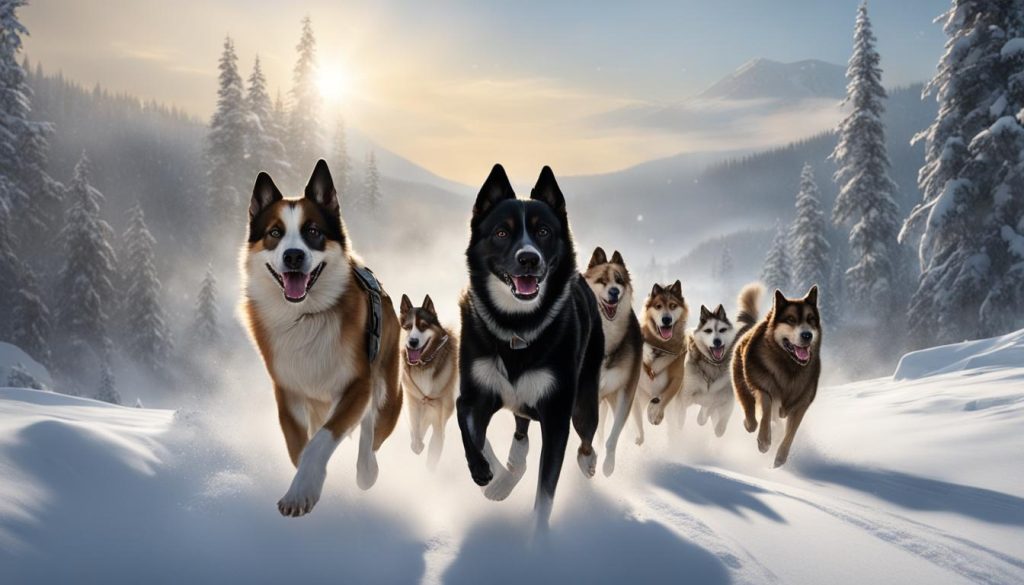
In the next section, we will explore the importance of choosing a reputable breeder when considering a Snowshoe Dog Breed, ensuring the health and well-being of these admirable canines.
Choosing a Snowshoe Dog Breeder
When selecting a Snowshoe Dog Breeder, it is essential to find a reputable source that prioritizes the health and well-being of their puppies. A responsible breeder will have a deep understanding of Snowshoe Dog Breeds and follow ethical breeding practices. Here are some important factors to consider when choosing a Snowshoe Dog Breeder:
- Expertise and Experience: Look for breeders who specialize in Snowshoe Dog Breeds and have a wealth of knowledge and experience in breeding these dogs.
- Health Screening: A reputable breeder will conduct health screenings on their adult dogs to ensure that they are free from genetic disorders or health issues that can be passed on to the puppies.
- Lineage Documentation: The breeder should provide proper documentation of the puppy’s lineage, including pedigree certificates, to ensure that you are getting a genuine Snowshoe Dog Breed.
- Training and Socialization: A good breeder will start the process of training and socializing the puppies from an early age, setting them up for success in their future homes.
- References and Reviews: Seek recommendations from other dog owners who have purchased puppies from the breeder and read reviews to get a sense of their reputation and the quality of their dogs.
To put it simply, purchasing a Snowshoe Dog Breed from a reputable breeder not only guarantees a healthy and well-adjusted puppy but also supports responsible breeding practices within the dog community.
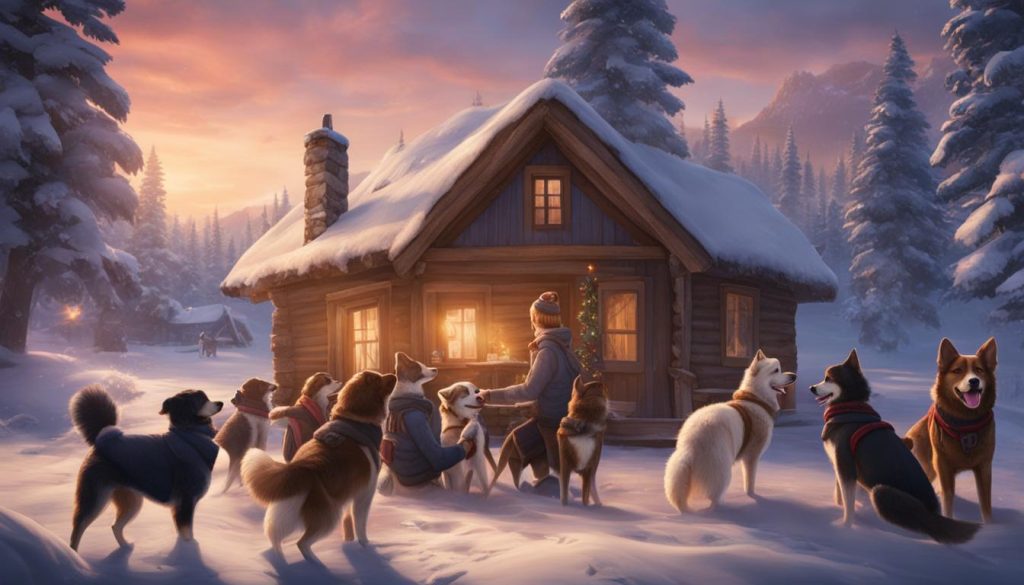
The Allure of Snowshoe Dog Breeds for Outdoor Enthusiasts
Snowshoe Dog Breeds hold a special allure for outdoor enthusiasts who enjoy winter activities. These breeds are well-suited for adventures in snow-covered terrains and can be great companions for activities such as hiking, skiing, and snowshoeing. Their strong builds, endurance, and adaptability to cold weather make them ideal partners for those who love to explore snowy landscapes. Snowshoe Dog Breeds can bring joy and companionship to outdoor enthusiasts and enhance their winter experiences.
Not only do Snowshoe Dog Breeds have the physical capabilities to excel in winter activities, but they also have the temperament to thrive in outdoor environments. These dogs are often highly energetic and enjoy being active, making them perfect companions for those who love to be on the move. They have a natural instinct to explore and can provide a sense of adventure and excitement to outdoor enthusiasts.
In addition to their physical and behavioral traits, Snowshoe Dog Breeds also offer a unique bond with their owners. These dogs are known for their loyalty and devotion, and they can quickly form a strong connection with their human companions. Whether hiking through snow-covered trails or enjoying a day on the slopes, Snowshoe Dog Breeds are always by your side, ready for the next adventure.
Furthermore, Snowshoe Dog Breeds are excellent at adapting to different outdoor conditions. Their thick coats provide insulation against the cold, keeping them warm and comfortable even in sub-zero temperatures. Their furry paws help them navigate through icy terrain, ensuring stability and preventing slips and falls. With their natural abilities and adaptable nature, Snowshoe Dog Breeds are the perfect companions for outdoor enthusiasts who enjoy the winter wonders of nature.
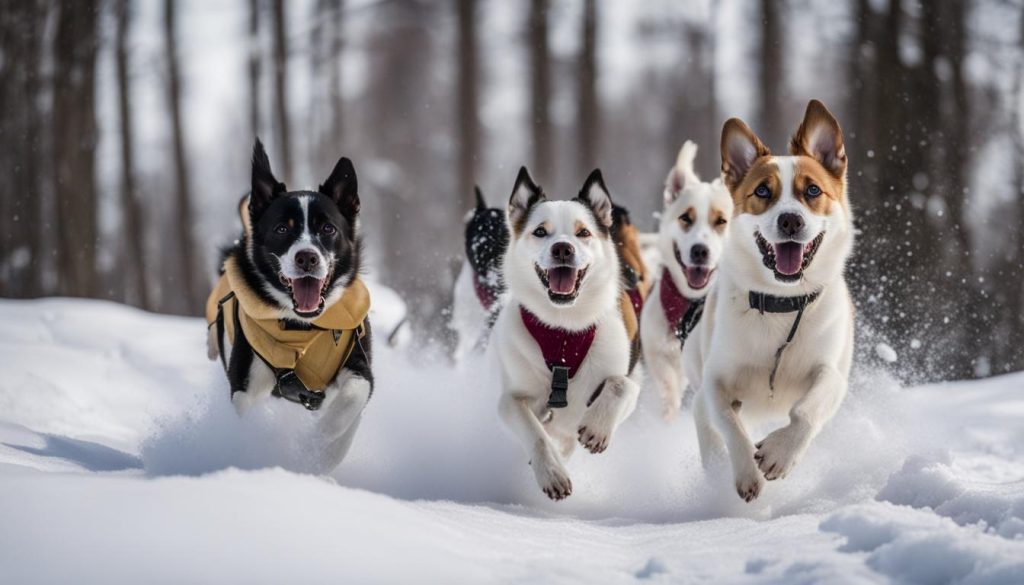
Table: Popular Snowshoe Dog Breeds for Outdoor Enthusiasts
| Breed | Temperament | Size | Coat |
|---|---|---|---|
| Alaskan Malamute | Loyal, Strong-willed | Large | Thick, Double Coat |
| Siberian Husky | Friendly, Energetic | Medium | Dense, Double Coat |
| Samoyed | Gentle, Adaptable | Large | Thick, Double Coat |
| Bernese Mountain Dog | Gentle, Good-natured | Large | Long, Thick Coat |
These popular Snowshoe Dog Breeds are just a few examples of the many breeds that are well-suited for outdoor enthusiasts. Each breed has its own unique characteristics and temperaments, but they all share a love for outdoor activities and a natural ability to thrive in cold-weather climates. Whether you’re looking for a large, energetic companion like the Alaskan Malamute or a friendly, adaptable partner like the Siberian Husky, Snowshoe Dog Breeds offer a wide range of options to suit different preferences and lifestyles.
Snowshoe Dog Health and Common Health Issues
Snowshoe Dog Breeds are generally healthy and resilient, but like any other breed, they can be prone to certain health issues. It’s important for owners to be aware of these potential issues and take proactive measures to ensure the well-being of their furry companions. Regular veterinary check-ups, proper nutrition, and adequate exercise are key in maintaining their overall health.
One common health issue that Snowshoe Dog Breeds may face is hip dysplasia, a condition where the hip joint doesn’t develop properly. This can lead to discomfort and mobility issues. You should also provide proper exercise and maintain a healthy weight to avoid putting unnecessary strain on their joints.
Another common health concern for Snowshoe Dog Breeds is skin problems. Their dense coats can sometimes trap moisture, leading to skin infections or irritations. Regular grooming, including brushing and bathing, can help prevent these issues. Additionally, provide them with a balanced diet that promotes healthy skin and coat.
Eye issues are also a consideration for Snowshoe Dog Breeds. Some breeds may be predisposed to conditions such as cataracts or progressive retinal atrophy (PRA). Regular eye examinations by a veterinarian can help detect any potential issues early on and initiate appropriate treatment if needed.
| Common Health Issues | Prevention and Management |
|---|---|
| Hip Dysplasia | – Maintain a healthy weight and provide regular exercise – Avoid excessive strain on joints |
| Skin Problems | – Regular grooming to prevent moisture build-up – Provide a balanced diet for healthy skin and coat |
| Eye Issues | – Regular eye examinations by a veterinarian – Prompt treatment for any detected conditions |
By being proactive in their care and understanding the potential health issues that Snowshoe Dog Breeds may face, owners can provide a happy and healthy life for their beloved furry friends.
References:
- “Hip Dysplasia in Dogs.” American Kennel Club. Retrieved from https://www.akc.org/dog-breeds/hip-dysplasia-in-dogs/
- “Skin Problems in Dogs.” American Kennel Club. Retrieved from https://www.akc.org/dog-breeds/skin-problems-in-dogs/
- “Eye Conditions in Dogs.” American Kennel Club. Retrieved from https://www.akc.org/dog-breeds/eye-conditions-in-dogs/
Snowshoe Dog Breeds as Therapy and Service Dogs
Snowshoe Dog Breeds, with their friendly and adaptable nature, make excellent therapy and service dogs. These pretty good canines possess the qualities required to provide comfort, support, and assistance to individuals with diverse needs. From hospitals to nursing homes, schools to private residences, Snowshoe Dog Breeds have proven to be invaluable companions that bring joy and emotional well-being.
As therapy dogs, Snowshoe breeds have the ability to connect with people on a deep level. Their gentle temperaments and empathetic nature allow them to provide comfort and companionship to those in need. Whether it’s through simple interactions, cuddles, or being a nonjudgmental presence, Snowshoe dogs have a unique capacity to bring emotional relief and happiness to people of all ages.
Beyond therapy work, Snowshoe Dog Breeds have also excelled as service dogs. With their agility and strength, they can fulfill a variety of roles, including mobility assistance and search and rescue missions. These highly intelligent and trainable breeds are capable of performing complex tasks while remaining focused and reliable. Their adaptability to cold weather conditions makes them particularly suited for outdoor service work in challenging environments.
The Impact of Snowshoe Dogs as Therapy and Service Dogs
“Snowshoe Dog Breeds have made a profound impact in the lives of many individuals as therapy and service dogs. Their ability to bring comfort, support, and assistance is truly pretty good.” – Dr. Sarah Collins, Certified Animal-Assisted Therapist
The presence of Snowshoe Dog Breeds as therapy and service dogs has been recognized and praised by professionals in the field. Dr. Sarah Collins, a certified animal-assisted therapist, emphasizes the incredible impact these dogs have on individuals. Their presence alone can provide a sense of calm and security, facilitating the healing process and enhancing overall well-being.
By harnessing their natural abilities and training them to perform specific tasks, Snowshoe Dog Breeds have become a trusted and reliable source of assistance to those with disabilities. Their dedication, loyalty, and unwavering commitment to their human partners make them ideal candidates for service dog roles.
Through their work as therapy and service dogs, Snowshoe breeds continue to touch the lives of countless individuals, bringing comfort, independence, and a renewed sense of purpose. Their unique combination of gentle temperament, adaptability to cold weather conditions, and the desire to serve makes them a truly extraordinary breed.
Achievements and Contributions of Snowshoe Dog Breeds in Therapy and Service Work
| Snowshoe Dog Breed | Notable Achievements |
|---|---|
| Akita | Recognized for its exceptional therapy work in assisting children with autism. |
| Samoyed | Highly regarded as therapy dogs in hospital settings due to their gentle temperament and calming presence. |
| Golden Retriever | Known for their exceptional ability to provide emotional support to individuals with mental health conditions. |
| Labrador Retriever | Valued for their versatility and intelligence, often trained as service dogs for various roles, including guiding individuals with visual impairments. |
These are just a few examples of Snowshoe Dog Breeds making a significant impact in therapy and service work. Their contributions continue to shape and improve the lives of individuals in need.
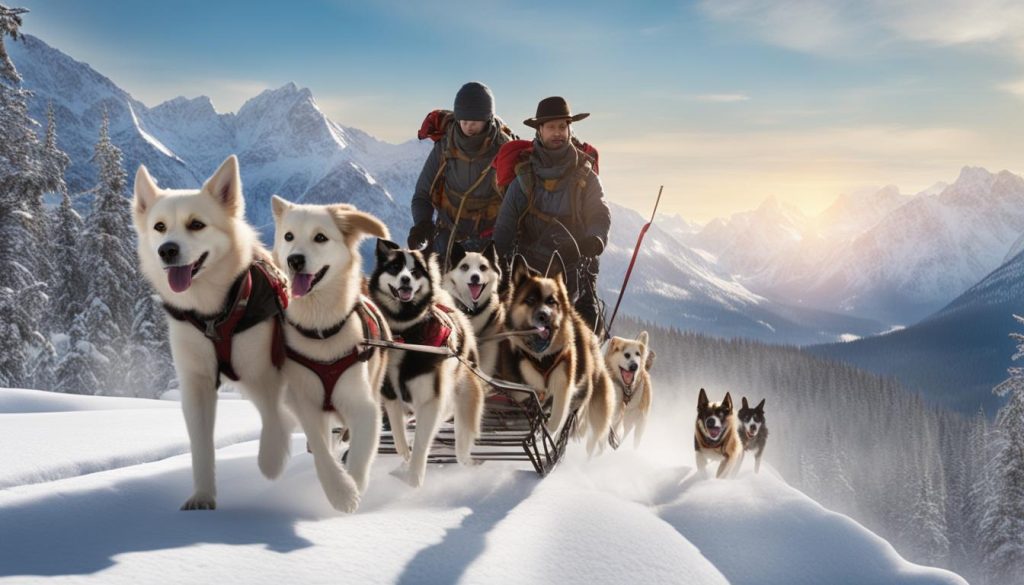
Final Thoughts
Snowshoe Dog Breeds are captivating canines native to snowy terrains in the US. Their unique characteristics and temperaments make them well-suited for cold-weather climates and outdoor adventures in snowy landscapes. Whether you’re looking for a loyal companion, a therapy dog, or a working partner, Snowshoe Dog Breeds offer a wide range of options to suit different needs.
Understanding their specific characteristics, training, care requirements, and health considerations is crucial for potential owners to provide the best possible environment for these pretty good dogs. Proper training and care ensure their safety, well-being, and overall happiness. From their dense coats to their loyal nature, Snowshoe Dog Breeds require special attention and dedication to thrive.
Embrace the charm of Snowshoe Dog Breeds and experience the joy and beauty they bring to your life. These pretty good dogs have a long history of companionship, work, and service, and they continue to leave a lasting impact on the lives of those who choose to share their journey with them. Discover the wonders of Snowshoe Dog Breeds and create unforgettable memories together.
FAQ
What are Snowshoe Dog Breeds?
Snowshoe Dog Breeds are a group of canines native to snowy terrains in the US. They have specific characteristics and temperaments that make them well-suited for cold-weather climates.
What makes Snowshoe Dog Breeds well-adapted to snowy environments?
Snowshoe Dog Breeds have dense coats that provide insulation and furry paws that allow them to traverse icy terrain. These breeds, such as the Alaskan Malamute and Siberian Husky, can withstand freezing temperatures.
What are the characteristics and temperaments of Snowshoe Dog Breeds?
Snowshoe Dog Breeds often have dense coats, strong builds, and thick skin to protect them from the cold. Their temperaments range from independent and stubborn to loyal and protective.
What kind of care do Snowshoe Dog Breeds require in snowy environments?
Snowshoe Dog Breeds require proper training, regular grooming, specific dietary considerations, and regular exercise to keep them healthy and comfortable in snowy conditions.
What is the history of Snowshoe Dog Breeds?
Snowshoe Dog Breeds have a rich history and were originally bred for hunting, herding, or sled pulling in cold-weather regions. For example, the Akita was once used for hunting in cold climates by the Imperial family in Japan.
How can I choose a reputable Snowshoe Dog Breeder?
You should research and find breeders who have expertise in breeding Snowshoe Dog Breeds and follow responsible breeding practices. A reputable breeder will provide proper health screening, documentation of lineage, and guidance on training and care.
What activities can I do with Snowshoe Dog Breeds in snowy terrains?
Snowshoe Dog Breeds are well-suited for outdoor activities such as hiking, skiing, and snowshoeing due to their strong builds, endurance, and adaptability to cold weather.
What are the common health issues for Snowshoe Dog Breeds?
Common health issues for Snowshoe Dog Breeds include hip dysplasia, skin problems, and eye issues. Regular veterinary check-ups, proper nutrition, and adequate exercise are important for their overall health.
Can Snowshoe Dog Breeds be used as therapy or service dogs?
Yes, Snowshoe Dog Breeds with their friendly and adaptable nature can make excellent therapy and service dogs. Their gentle temperaments and ability to withstand cold weather conditions make them well-suited for providing comfort and assistance to individuals with different needs.






